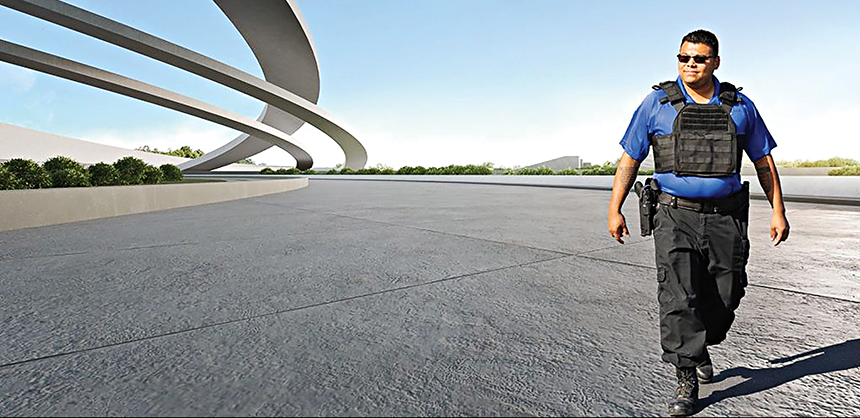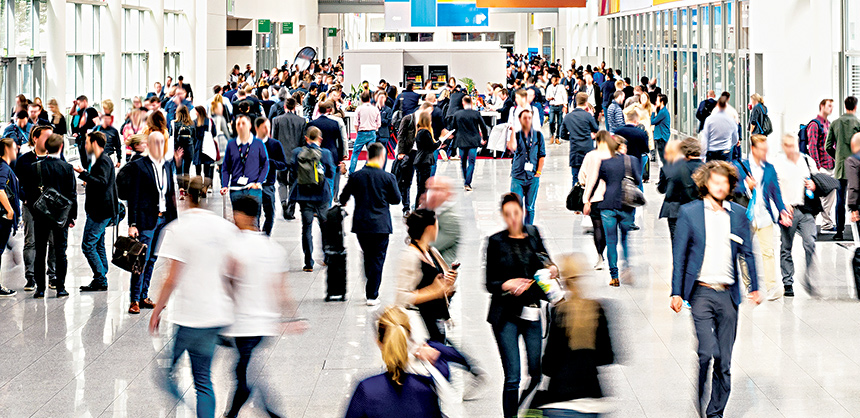Crisis Control: Managing Security RisksApril 3, 2023
Ways Insurance and Financial Planners Put Safety and Security First By Maura KellerCrisis Control: Managing Security Risks
Ways Insurance and Financial Planners Put Safety and Security First
Glen Bhimani, founder and CEO of BPS Security, says the general issues that event planners have always faced have not changed, but what has changed is the manner in which they are being approached by criminals. Courtesy Photo
After opening a few newspapers or websites about news, planners can read all about the safety and security issues in arenas, shopping malls, restaurants, schools, airports and other destinations. So, what are the inherent safety and security risks in the meetings and events industry — and what steps can meeting professionals take to mitigate incidents? Safety and security has become much more complex in recent years.
Amanda Ma, meeting planner and CEO of Innovate Marketing Group, an event management agency, points out that the safety and security of meetings and events have evolved, largely due to the increasing prevalence of technology and the increasing threat of terrorism. Ma says the biggest concerns today are cybersecurity, privacy and physical security.
“In terms of cybersecurity, the rise of digital devices and the internet have created new vulnerabilities for event organizers to address,” Ma says. “For example, events now need to be mindful of the potential for hacking, data breaches and the theft of sensitive information. This has led to an increased focus on secure communication protocols and secure-data storage-methods.”
Privacy is also a growing concern, particularly in light of new data-protection laws and regulations. According to Ma, meeting planners must ensure that they are fully compliant with these regulations and that they are taking steps to protect attendees’ personal information. This can involve practicing strict-access controls, encrypting sensitive data and regularly monitoring systems for security breaches.
“Physical security has become a top priority for event organizers,” Ma says. “The threat of terrorism and mass shootings has led to increased security measures at events, including enhanced screening procedures, increased police presence, and the use of metal detectors and other security technologies. In addition, emergency response plans have become more sophisticated and better tested to ensure that organizers are prepared to respond quickly and effectively in the event of an emergency.”
Glen Bhimani, founder and CEO of BPS Security, says the general issues that event planners have always faced have not changed, but what has changed is the manner in which they are being approached by criminals. “No one can control what manner of criminal offense or emergency might happen, so an event planner needs to focus on what they can control,” he says. “And because of this, many of the old-school techniques for providing security at an event still apply, such as restricting access and making sure that everyone on the property or in the room has been screened.”
Security Steps To Include
Emily Hartstone, professional meeting planner, Pandemic Compliance Advisor for the meetings industry, and CEO of From the Hart Management, says the biggest change in safety and security has been the global pandemic.
“A decade ago, our largest concern was terrorism and controlling large crowds,” Hartstone says. “Now, we have to add in public health concerns like social distancing measures and heightened security due do social threats, as well as GDPR (general data protection regulation) compliancy due to data theft.”
Depending on what type of event you are planning, Hartstone says there are different safety precautions that planners should take. However, there are certain must-do precautions for any type of event. For instance, every planner should first carry out a risk assessment to identify potential hazards and threats to the safety and security of attendees. This includes assessing the venue, transportation and the local environment.
“A proper risk assessment identifies potential hazards around the event and who can be harmed as a result, as it’s a planner’s responsibility to protect their staff in addition to the attendees,” Hartstone says. “It also identifies why the hazard might occur and the probability of it happening.”
Another step planners should take in their overall event management plan includes a health and safety plan. As Hartstone explains, this should have clear, defined staff roles and responsibilities, an event program, speaker and/or performance times, and contact information for all on-site staff and vendors. First aid certification, which tests skills in responding to medical emergencies until emergency responders arrive, can be supplemented by CPR and AED certification. CPR stands for Cardiopulmonary Resuscitation and AED for Automated External Defibrillator.
“I personally prefer to bring or hire staff who is already well trained in the field, however should training be required, it should be done well before the event,” Hartstone says “Having someone on-site who is certified in CPR/AED and first aid certified a highly recommended, especially as we’ve seen how easily it can save a life in recent events, such as in the NFL. If it’s a larger event like a festival, planners can hire an ambulance and medical staff to remain on-site should a true emergency occur.”
Venues often require it, but even when they don’t, Hartstone says, it’s a good idea to look at the fire safety code and meet with the local fire department and other officials, especially if you are planning an event like a music festival or sporting event. “For smaller events like trade shows and conferences, a fire marshal will usually need to look over the floor plan for any exhibits,” Hartstone says. “Planners want to ensure there are no exposed wires, and WiFi networks and control panels should not be accessible to attendees under any circumstance.”
And event planners should have both a crisis communication plan and an evacuation plan. These outline how attendees will be informed of any safety and security issues during the event. As Hartstone explains, your on-site staff should already be trained to respond to these situations, “The communication channels should also have already been included in the written management and health and safety plans prior to the event,” she says.
Moreover, Bhimani says planners need to take into account what kind of risks the event or meeting itself will bring. Questions to ask include:
- Is there any form of “value” that is going to be at this event?
- Is it something that could be stolen?
- Is there likely to be “flaring tempers” at this event?
- Will alcohol be present and its associated risks assessed?
Planners can work with security professionals to practice appropriate security measures, such as bag checks, metal detectors and surveillance cameras. “You absolutely need to bring in an independent security consultant. Your best bet is to pay someone to come in who you will not be hiring as security though, so they are only focused on the consultation and not selling you – to provide you with a realistic look at what needs to be accomplished to make your event safe,” Bhimani says.
Bill Herzog, CEO of LionHeart Security Services, agrees that meeting planners need to hire the appropriate amount of security — have exits and entrances covered, have outdoor areas covered such as parking lots, and have unused doors and access points secured. “Technology helps with physical security in terms of cameras and monitoring devices,” he says. “You can also use card readers for people to get in and out of the events, as well as metal detectors. With the cameras you must make sure there is active monitoring of the video, especially outdoor cameras so security can see potential approaching threats.”

For smaller events like trade shows and conferences, a fire marshal will usually need to look over the floor plan for any exhibits, according to From the Hart Management CEO Emily Hartstone. DepositPhotos.com
Embracing Challenges
Ma says planners face a variety of challenges when it comes to ensuring the safety of their events including:
- Balancing security and attendee experience: Planners must find a way to practice the necessary safety measures, while still providing a positive experience for attendees.
- Staying ahead of evolving security risks: The nature of security threats is constantly changing, and planners must stay informed and adapt their plans accordingly.
- Budget limitations: Implementing adequate safety measures can be expensive, and planners may face budget constraints that limit their ability to provide a secure environment for attendees.
- Coordination with multiple stakeholders: Safety at events often requires coordination with local law enforcement, venue management and technology providers, which can be complex and time-consuming.
- Rapid response to unexpected incidents: Planners must be prepared to respond quickly and effectively in the event of an emergency and make real-time decisions to ensure the safety of attendees.
One challenge many planners still need to consider involves data breaches. “As an industry, we need be much better about training our planners on how easily this can happen,” Hartstone says. “We’ve all printed a last-minute attendee list on site and realized we printed the excel cells too small. Have you just tossed it in the garbage? Someone can easily go pick that up. How often does an AV-exhibit company request your dilatated spreadsheet? Are they asking to receive it from you in an encrypted format? From a planner unintentionally putting data of their attendees into the wrong hands, to printing attendee lists on public WiFi, and even device theft, data-theft has quickly become a huge concern.”
In many situations, Bhimani says planners think of security last and only budget barely enough to get one or two guards to help with the event. Unfortunately, this approach to security causes more problems.
“Think of all of the shootings that occur: most of them happen at … schools, malls, and unprotected churches where there is little to no budget for protection, safety and security,” Bhimani says. “The places that you don’t hear of security breaches? Those are the places with the top-of-the-line security, or at least enough of a security budget to avoid being an easy target. The truth is proactive protection is the best kind of protection.”
An Ongoing Concern is Cybersecurity
“As technology continues to advance, planners can expect to see the integration of new tools and systems to enhance safety and security at events,” Ma says. “There will also be a greater emphasis on cybersecurity: With the increasing risk of hacking and data breaches, planners will need to focus on protecting against cyber-threats.”
Indeed, Bhimani also points to technology’s impact on meetings and events, which now includes threats to attendees personal information and information/data leaks. “It’s important to physically remove microphones that can be hacked from the room and check phones at the door,” Bhimani says. “There aren’t really any specific tools or pieces of technology that have developed to combat this for the public — or to help event planners with the security aspect of their jobs — because knowledge is the best tool in terms of security and safety.”
There are many different groups and resources that can be used to provide safety for an event, which Bhimani recommends looking up.“I think safety and security issues will largely remain the same until some huge technological innovation comes on the scene,” Bhimani says. “The issues faced in terms of security and safety aren’t changing, just the landscape they are facing. Stay on top of innovation and technological changes, and you’ll be ready for whatever comes next in the realm of meeting safety.” I&FMM








